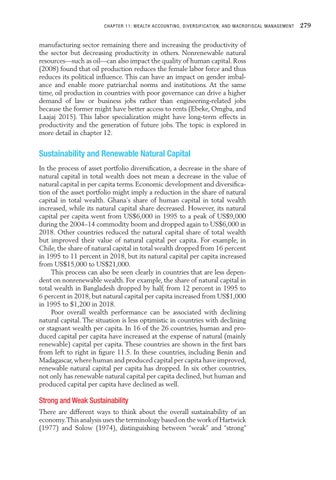CH AP TE R 11: Wealth Acco un ting, D iv ers if ication, a nd Macr o fi scal M a na geme nt
manufacturing sector remaining there and increasing the productivity of the sector but decreasing productivity in others. Nonrenewable natural resources—such as oil—can also impact the quality of human capital. Ross (2008) found that oil production reduces the female labor force and thus reduces its political influence. This can have an impact on gender imbalance and enable more patriarchal norms and institutions. At the same time, oil production in countries with poor governance can drive a higher demand of law or business jobs rather than engineering-related jobs because the former might have better access to rents (Ebeke, Omgba, and Laajaj 2015). This labor specialization might have long-term effects in productivity and the generation of future jobs. The topic is explored in more detail in chapter 12.
Sustainability and Renewable Natural Capital In the process of asset portfolio diversification, a decrease in the share of natural capital in total wealth does not mean a decrease in the value of natural capital in per capita terms. Economic development and diversification of the asset portfolio might imply a reduction in the share of natural capital in total wealth. Ghana’s share of human capital in total wealth increased, while its natural capital share decreased. However, its natural capital per capita went from US$6,000 in 1995 to a peak of US$9,000 during the 2004–14 commodity boom and dropped again to US$6,000 in 2018. Other countries reduced the natural capital share of total wealth but improved their value of natural capital per capita. For example, in Chile, the share of natural capital in total wealth dropped from 16 percent in 1995 to 11 percent in 2018, but its natural capital per capita increased from US$15,000 to US$21,000. This process can also be seen clearly in countries that are less dependent on nonrenewable wealth. For example, the share of natural capital in total wealth in Bangladesh dropped by half, from 12 percent in 1995 to 6 percent in 2018, but natural capital per capita increased from US$1,000 in 1995 to $1,200 in 2018. Poor overall wealth performance can be associated with declining natural capital. The situation is less optimistic in countries with declining or stagnant wealth per capita. In 16 of the 26 countries, human and produced capital per capita have increased at the expense of natural (mainly renewable) capital per capita. These countries are shown in the first bars from left to right in figure 11.5. In these countries, including Benin and Madagascar, where human and produced capital per capita have improved, renewable natural capital per capita has dropped. In six other countries, not only has renewable natural capital per capita declined, but human and produced capital per capita have declined as well.
Strong and Weak Sustainability There are different ways to think about the overall sustainability of an economy. This analysis uses the terminology based on the work of Hartwick (1977) and Solow (1974), distinguishing between “weak” and “strong”
279


